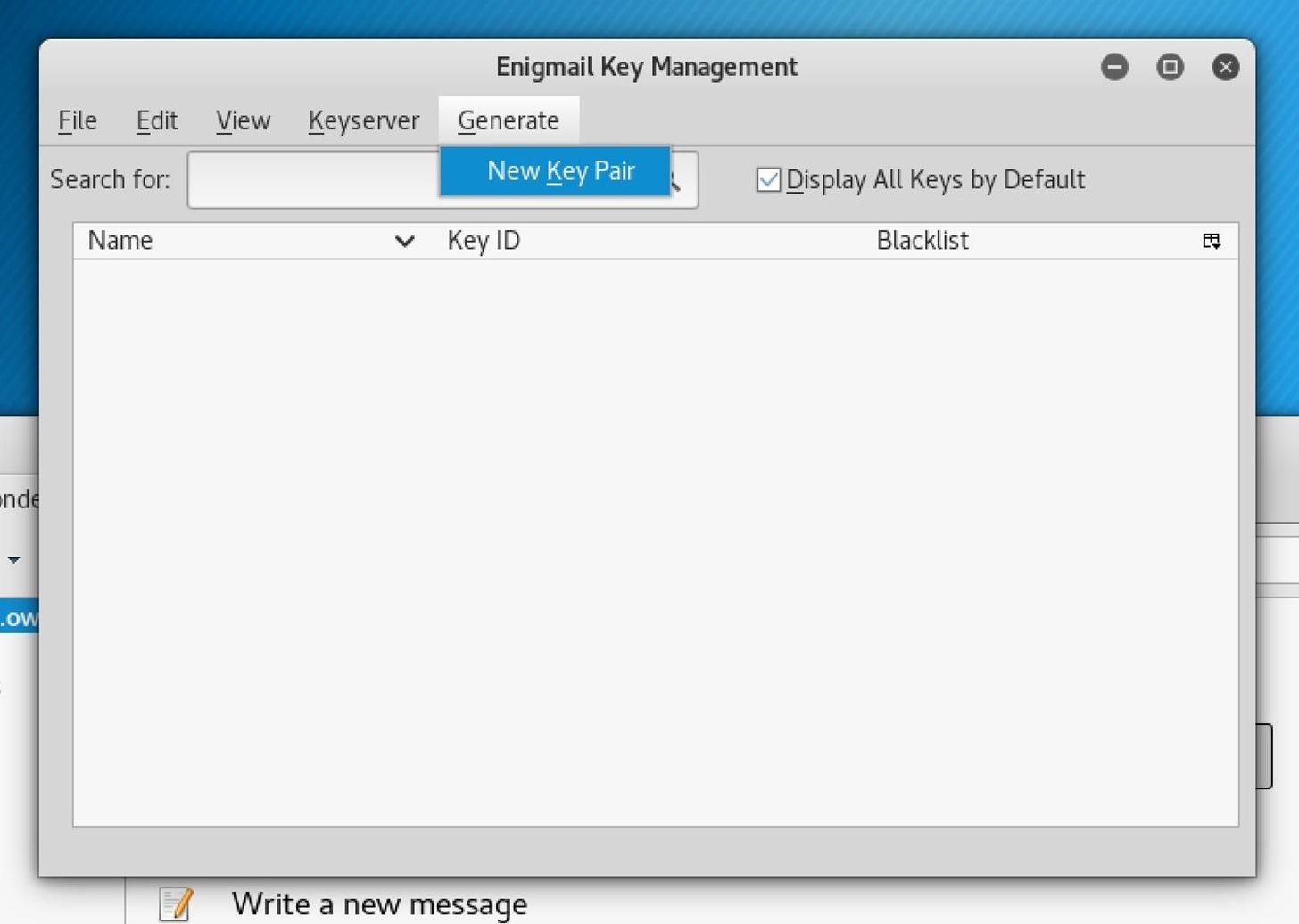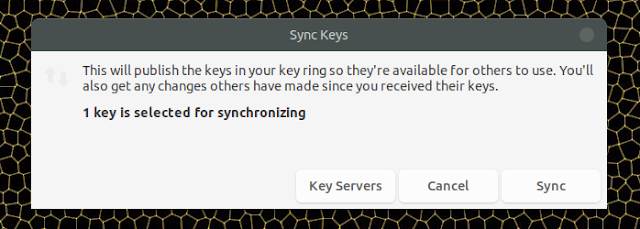Generate Public Pgp Key Linux
As we continue our series of articles on security, today we are going to cover personal security in the form of using PGP keys. Let’s talk about what PGP is, why it is important and how we can use it to generate the public and private keys needed to increase our personal security profile for. 2020-3-27 How do I make a PGP key? I'd like to have it for signing PPA uploads and such. 3 Answers Active Oldest Votes. Generating a PGP Key. Here is a GUI way to generate a new PGP key. Open the Passwords and Keys (Seahorse) application. Consisting of both your private key and public key. To use PGP in ur correspondence.
- Generate Public Pgp Key Linux Download
- Generate Public Pgp Key Linux Version
- How To Generate Public Pgp Key
Encryption is a process of embedding plain text data in such a way that it cannot be decoded by outsiders. It is necessary to encrypt data to prevent misuse. The GNU Privacy Guard (GPG) application allows you to encrypt and decrypt information. It is based on the use of a pair of keys, one public and one private (or secret). Data encrypted with one key can only be decrypted with the other. To encrypt a message to you, someone would use your public key to create a message that could only be unlocked with your private key. To sign information, you would lock it with your private key, allowing anyone to verify that it came from you by unlocking it with your public key.
Modern Linux distributions have gpg already installed on them. If not present, install it.
May 28, 2015 This blog describes how to generate a private/public key pair using GPG version 1.4.5. The resulting public key will contain two keys, one key for signing and a subkey for encryption. This key can be used with HCM Fusion SaaS to encrypt/decrypt files as they are transferred to and from the UCM server. Save the text file in the same folder where you saved the private key, using the.pub extension to indicate that the file contains a public key. If you or others are going to use an SSH client that requires the OpenSSH format for private keys (such as the ssh utility on Linux), export the private key: On the Conversions menu, choose Export. Nov 14, 2019 If you specify a user, the command exports the public key for that user, otherwise it exports the public keys for all users on the public keyring. Following, Deepak writes his public key to deepakpgp.asc and then displays that file. root@node1 # gpg -export -armor -output deepakpgp.asc deepak.prasad@test.com.
I have generated keys using GPG, by executing the following command gpg -gen-key Now I need to export the key pair to a file; i.e., private and public keys to private.pgp and public.pgp, respect. GNU gpg is encryption and signing tool. Adblock detected 😱 My website is made possible by displaying online advertisements to my visitors. Ads are annoying but they help keep this website running. It is hard to keep the site running and producing new content when so many people block ads. Please consider Continue reading 'Linux create your own GnuPG private and public key'.
on Centos
on Ubuntu
1) Create gpg key
When installing gnupg package, we need to understand the concept to use gpg as well.
Generating a new keypair
To encrypt your communication, the first thing to do is to create a new keypair. GPG is able to create several types of keypairs, but a primary key must be capable of making signatures.
uid:Please take a note about the USER-ID mentioned in the result. We will use its value to do some operation.pub:It represents the public key. The key-id is BAC361F1. Yours will be differentsub:It represents subkeys, goes along with the primary key. Commonly, it is used to encryption.
Your prompt can be handled for a very long time without finishing if you see the message below
'Not enough random bytes available. Please do some other work to give
the OS a chance to collect more entropy! (Need 285 more bytes)'
The problem is caused by the lack of entropy (or random system noise). So cancel the process and check the available entropy
You can see it is not enough. We can install a package to solve the lack of entropy with rngd which is a random number generator utility used to check immediately the available entropy
Now can start again with the gpg --gen-key command and the process will be fine. We have only installed it without anything else. In certain distributions, you need to use rngd before the gpg process.
3) Generating a revocation certificate
After your keypair is created you should immediately generate a revocation certificate to revoke your public key if your private key has been compromised in any way or if you lose it. Create it when you create your key. The process requires your private key, passphrase.
The argument BAC361F1 is the key ID. It must be a key specifier, either the key ID of your primary keypair or any part of a user ID that identifies your keypair like my_name@linoxide.com. The generated certificate will be saved in revoke_key.asc file. Store it where others can't access it because anybody having access to it can revoke your key, rendering it useless. If the --output option is omitted, the result will be placed on standard output.
4) Making an ASCII armored version of your public key
Some keyservers allow you to paste an ASCII armored version of your public key in order to upload it directly. This method is most preferred because the key comes directly from the user who can see that the key has been successfully uploaded.
5) Exchanging keys
In order to communicate with others, you must exchange public keys. To do it, you must be able to list your keys. There is some commands to list your public keyring
gpg --list-keys:List all keys from the public keyrings, or just the keys given on the command line.gpg --list-secret-keys:List all keys from the secret keyrings or just the ones given on the command linegpg --list-sigs:Same as --list-keys, but the signatures are listed too.
Export a public key
Now that you have generated a key pair, the next step is to publish your public key on internet ( Keyservers ) so that other person can use it to send you a message. You can use either the key ID or any part of the user ID may be used to identify the key to export. There are two commands but with the first command, the key is exported in a binary format and can be inconvenient when it is sent through email or published on a web page. So, we will use the second command for ASCII armored method.
The output will be redirected to my_pubkey.gpg file which has the content of the public key to provide for communication.
You are not limited to installing the trigger on your PC. The system supports both Windows 7 Activator 64 bit and a 32-bit system. Key generator free download for windows 7. You do not have to worry that someone will scan your PC because it has used the activator. The tool is fully encrypted. This means that your security and privacy is maintained safely.
Submit your public keys to a keyserver
Once you have this ASCII-armored public key, you can manually paste it into a form at a public key server like pgp.mit.edu
Because someone seems to have sent you their public key, there's no reason to trust that it's from that person unless you have validated it.


Import a public key
As others persons can use your public key to send you a message, you can import public from people you trust in to communicate with them.
Generate Public Pgp Key Linux Download
Conclusion
Now we have notions on the principles to use and generate a public key. You know how GnuPG is functioning and you can use it for secure communication. GPG encryption is only useful when both parties use good security practices and are vigilant.
Read Also:
Generate Public Pgp Key Linux Version
The PuTTYgen program is part of PuTTY, an open source networking client for the Windows platform.
How To Generate Public Pgp Key
- Download and install PuTTY or PuTTYgen.
To download PuTTY or PuTTYgen, go to http://www.putty.org/ and click the You can download PuTTY here link.
- Run the PuTTYgen program.
- Set the Type of key to generate option to SSH-2 RSA.
- In the Number of bits in a generated key box, enter 2048.
- Click Generate to generate a public/private key pair.
As the key is being generated, move the mouse around the blank area as directed.
- (Optional) Enter a passphrase for the private key in the Key passphrase box and reenter it in the Confirm passphrase box.
Note:
While a passphrase is not required, you should specify one as a security measure to protect the private key from unauthorized use. When you specify a passphrase, a user must enter the passphrase every time the private key is used.
- Click Save private key to save the private key to a file. To adhere to file-naming conventions, you should give the private key file an extension of
.ppk(PuTTY private key).Note:
The.ppkfile extension indicates that the private key is in PuTTY's proprietary format. You must use a key of this format when using PuTTY as your SSH client. It cannot be used with other SSH client tools. Refer to the PuTTY documentation to convert a private key in this format to a different format. - Select all of the characters in the Public key for pasting into OpenSSH authorized_keys file box.
Make sure you select all the characters, not just the ones you can see in the narrow window. If a scroll bar is next to the characters, you aren't seeing all the characters.
- Right-click somewhere in the selected text and select Copy from the menu.
- Open a text editor and paste the characters, just as you copied them. Start at the first character in the text editor, and do not insert any line breaks.
- Save the text file in the same folder where you saved the private key, using the
.pubextension to indicate that the file contains a public key. - If you or others are going to use an SSH client that requires the OpenSSH format for private keys (such as the
sshutility on Linux), export the private key:- On the Conversions menu, choose Export OpenSSH key.
- Save the private key in OpenSSH format in the same folder where you saved the private key in
.ppkformat, using an extension such as.opensshto indicate the file's content.